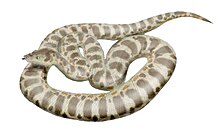泰坦巨蟒属
泰坦蚺屬(學名:Titanoboa,意即「極大的蚺蛇」)[1]是一個生活在古新世(約 6,000 至 5,800 萬年前)哥倫比亞東北部瓜希拉省的無毒、肉食性蚺类。[2]已知的唯一種塞雷洪泰坦蚺(T. cerrejonensis)也是已知最大的蛇。[2]把它石化的脊椎骨與現代蛇比較,研究人員估計其最大全長14米(46英呎),體重超過1,100公斤(2,400磅),身體最粗處厚達1米(3.3英呎)。[2]它可能是以鱷魚為食的。[3]
| 泰坦蚺屬 化石时期:中 - 晚古新世
| |
|---|---|

| |
| 泰坦蚺復原圖 | |
| 科学分类 | |
| 界: | 动物界 Animalia |
| 门: | 脊索动物门 Chordata |
| 纲: | 爬行綱 Reptilia |
| 目: | 有鳞目 Squamata |
| 亚目: | 蛇亚目 Serpentes |
| 科: | 蚺科 Boidae |
| 亚科: | 蚺亚科 Boinae |
| 属: | †泰坦蚺屬 Titanoboa Head et al. 2009 |
| 種 | |
| |
發現
编辑二十八條巨蚺的化石是在2009年在哥倫比亞北部的塞雷洪煤礦被發現的。[1][2]在此以前,在南美洲昔日的熱帶地區很少有古新世的脊椎動物被發現。[4]
此種是由一隊由佛羅里達大學研究脊椎動物的古生物學家約納森·希洛克(Jonathan Bloch)和巴拿馬史密森尼熱帶研究所的古植物學家卡洛斯·哈拉米約(Carlos Jaramillo)率領的國際科學考察隊伍發現的。[5]
體型與溫度的關係
编辑由於蛇是環溫動物,這項發現也暗示了,當時的其生活的熱帶地區比研究人員原先估計的更溫暖,平均氣溫為 32℃(90°F)。[1][2][6][7]只有這樣的氣候才能讓蛇長得這麼大。[8][9]而目前當地的年平均氣溫為 28℃。[10]
然而,一些研究人員不同意上述估計。例如,2009年在“自然”雜誌上的研究,應用上述的數學模型在溫帶澳大利亞古蜥蜴化石,預測目前生活在熱帶地區的蜥蜴應該能夠達到33英尺,這顯然不是這樣的。 [11]
另一個在同一期雜誌上馬克·丹尼(生物力學方面的專家)發表的批評指出,這條蛇是如此之大並且產生這麼多的代謝熱量,環境溫度必須比目前的溫度低四到六度,否則蛇會有過熱的危險。[12]
體型比較
编辑二十八條蛇中最大的八條重約 2,500 磅(1,136 公斤),體長 12—15 米(37—50 英呎)。而現存最大的蛇,包括長約 7.5 米(24 英呎)的森蚺(最重的蛇)[13]和長約 9.9 米(32.5英呎)的網紋蟒(最長的蛇)。[3]而現存最小的蛇,卡拉細盲蛇,身長只有10 公分(4 英吋)。[14]此前最長的化石蛇,是非洲巨蟒,出土自埃及,長 10 米。[15]
參考文獻
编辑- ^ 1.0 1.1 1.2 Head, Jason J.; Jonathan I. Bloch, Alexander K. Hastings, Jason R. Bourque, Edwin A. Cadena, Fabiany A. Herrera, P. David Polly, and Carlos A. Jaramillo. Giant boid snake from the paleocene neotropics reveals hotr past equatorial temperatures.. Nature: 715–718. [2009-02-05]. (原始内容存档于2017-03-07).
- ^ 2.0 2.1 2.2 2.3 2.4 Kwok, Roberta. Scientists find world's biggest snake. Nature. 4 February 2009 [4 February 2009]. (原始内容存档于2019-09-07).
- ^ 3.0 3.1 CTV: Ancient, gargantuan snakes ate crocs for breakfast. CTV電視網. February 4, 2009 [4 February 2009]. (原始内容存档于2009-02-06).
- ^ Maugh II, Thomas H. Fossil of 43-foot super snake Titanoboa found in Colombia. 洛杉磯時報. 4 February 2009 [4 February 2009]. (原始内容存档于2009-02-06).
- ^ At 2,500 Pounds And 43 Feet, Prehistoric Snake Is Largest On Record. 科學日報. February 4, 2009 [4 February 2009]. (原始内容存档于2017-08-11).
- ^ Joyce, Christopher. 1-Ton Snakes Once Slithered In The Tropics. 全國公共廣播電台. 5 February 2009 [5 February 2009]. (原始内容存档于2019-01-07).
- ^ Science Direct: Climate model sensitivity to atmospheric CO2 levels in the Early–Middle Paleogene. [2009-02-06]. (原始内容存档于2009-02-08).
- ^ The Royal Society: Gigantism, temperature and metabolic rate in terrestrial poikilotherms. [2009-02-06]. (原始内容存档于2020-02-02).
- ^ AP: Video of Titanoboa. [2009-02-06]. (原始内容存档于2009-02-08).
- ^ 南美出土13米长巨型蚺蛇化石. BBC中文網. 2009年2月4日 [2009年2月6日]. (原始内容存档于2009年2月7日).
- ^ J. M. Kale Sniderman. Biased reptilian palaeothermometer?. [2009-07-30]. (原始内容存档于2018-09-30).
- ^ Mark W. Denny1, Brent L. Lockwood1 & George N. Somero. Can the giant snake predict palaeoclimate?. [2009-07-30]. (原始内容存档于2009-08-03).
- ^ Mehrtens JM. 1987. Living Snakes of the World in Color. New York: Sterling Publishers. 480 pp. ISBN 0-8069-6460-X.
- ^ S. Blair Hedges. At the lower size limit in snakes: two new species of threadsnakes (Squamata: Leptotyphlopidae: Leptotyphlops) from the Lesser Antilles (PDF). Zootaxa. August 4, 2008, 1841: 1–30 [2008-08-04]. (原始内容存档 (PDF)于2019-07-24).
- ^ 巨蛇化石残骸在哥伦比亚发现. 美國之音. 2009年2月5日 [2009-02-06]. (原始内容存档于2009-02-08).
外部連結
编辑- 研究显示一种远古巨蛇可能是迄今最长蛇类. 新華社. 2009年2月5日 [2009年2月6日]. (原始内容存档于2009年2月8日).